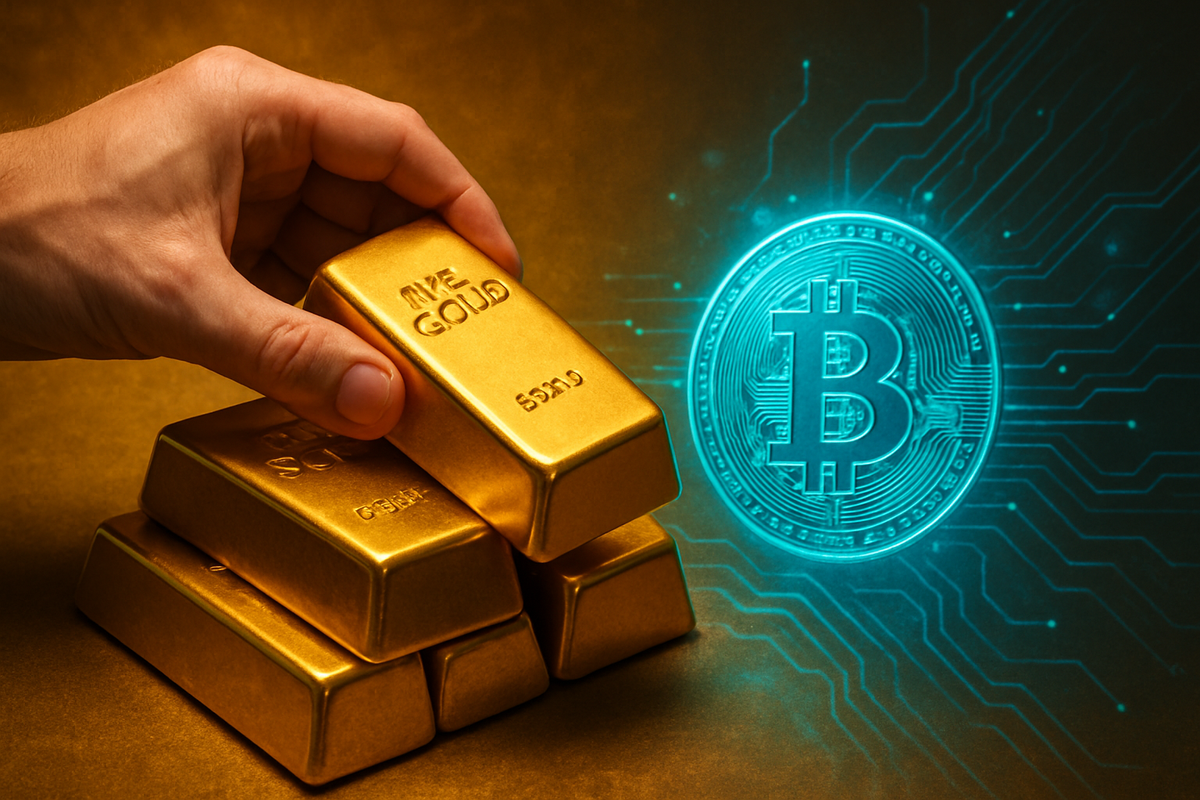
A palpable "gold fever" has gripped global financial markets, with the precious metal scaling unprecedented heights as investors flock to its traditional safe-haven allure. This surge, fueled by a cocktail of geopolitical instability, persistent inflation concerns, and shifting central bank policies, has ignited a fervent debate: could Bitcoin, often dubbed "digital gold," be next in line for a similar, transformative rally? As the world grapples with economic uncertainties, the spotlight intensifies on these two seemingly disparate assets, prompting a closer look at their drivers, divergences, and potential intertwined futures.
The Midas Touch: Unpacking Gold's Historic Rally
Gold's journey to record valuations has been nothing short of spectacular, culminating in a series of all-time high closes throughout late 2024 and early 2025. The metal's price has soared past the $2,400 per ounce mark, a testament to its enduring appeal in turbulent times. This remarkable ascent can be traced through a confluence of global events. The ongoing conflict in Ukraine, coupled with escalating tensions in the Middle East, has significantly amplified demand for safe-haven assets. Concurrently, persistent inflationary pressures, initially dismissed as transitory, have proven more stubborn, eroding purchasing power and driving investors to assets perceived as inflation hedges. Central banks, particularly those in emerging economies, have also emerged as significant buyers, diversifying reserves away from traditional fiat currencies and further bolstering gold's demand. The timeline leading to this moment has seen a steady build-up of these factors, creating a perfect storm for gold's rally. Key players range from individual retail investors seeking protection for their savings to massive institutional funds and sovereign wealth entities rebalancing their portfolios. Initial market reactions have been overwhelmingly bullish, with many analysts forecasting continued strength as long as global uncertainties persist, cementing gold's role as a fundamental pillar of crisis-era investing.
Mining for Profits: Winners and Losers in the Gold Rush
The resurgence of gold prices has created a clear hierarchy of beneficiaries and those indirectly affected within the market. Unsurprisingly, major gold mining companies are at the forefront of the winners' circle. Giants like Barrick Gold (NYSE: GOLD) and Newmont (NYSE: NEM) have seen their stock prices rally, buoyed by improved profit margins as the cost of extraction remains relatively stable while the selling price of their output skyrockets. Increased revenue translates into stronger balance sheets, potential dividend increases, and expanded exploration budgets, promising future growth. Smaller, junior mining companies also stand to benefit significantly, as higher gold prices make previously uneconomical deposits viable, attracting new investment and potentially leading to acquisitions.
Conversely, companies heavily reliant on consumer discretionary spending or those with high debt loads might face indirect headwinds. While not direct "losers," a sustained flight to safety could divert capital away from riskier growth stocks, impacting their valuations. Furthermore, some financial institutions that might have underweight positions in precious metals could see their relative performance suffer compared to peers who allocated more strategically. The broader impact extends to sectors sensitive to interest rate hikes – which often accompany inflation fears that drive gold – as borrowing costs increase, potentially squeezing margins for businesses across various industries.
Beyond the Gleam: Gold's Significance and Bitcoin's Echo
Gold's current rally is not an isolated event but rather a symptom of deeper, broader industry trends reflecting a fundamental shift in global economic sentiment. It underscores a growing distrust in traditional fiat currencies and a desire for tangible, decentralized stores of value. This phenomenon fits neatly into broader themes of de-dollarization, as nations and investors seek to reduce their reliance on the U.S. dollar, and a general flight to quality amidst geopolitical fragmentation. The regulatory landscape for gold, a historically established asset, remains stable, offering a stark contrast to the nascent and often turbulent regulatory environment surrounding cryptocurrencies. Historically, gold has served as the ultimate safe haven during economic crises, from the Great Depression to the 2008 financial crisis, providing a reliable hedge against inflation and market volatility.
This context provides a compelling backdrop for considering Bitcoin's potential. Often hailed as "digital gold," Bitcoin shares several key characteristics with its physical counterpart: a finite supply, resistance to censorship, and a decentralized nature. Its "halving" events, which periodically reduce the rate of new Bitcoin creation, mirror gold's scarcity. However, Bitcoin’s journey has been far more volatile, grappling with regulatory uncertainty, scalability issues, and a shorter track record. Yet, its increasing institutional adoption, particularly with the advent of spot Bitcoin ETFs, and its growing recognition as a legitimate asset class, suggest it is maturing. As investors seek alternatives to traditional financial systems, the narrative of Bitcoin as a complementary or even superior digital store of value gains traction, potentially positioning it for a future surge akin to gold's.
The Horizon: What Comes Next for Gold and Crypto
Looking ahead, the trajectory for both gold and Bitcoin appears dynamic, with a multitude of factors poised to influence their performance. In the short term, gold's price will likely remain sensitive to geopolitical developments, central bank interest rate decisions, and the persistence of inflation. Any de-escalation of conflicts or a clear path to disinflation could temper its ascent, while continued uncertainty would likely sustain demand. Long-term possibilities for gold include its continued role as a foundational reserve asset for central banks and a hedge against systemic risks, potentially pushing its valuation even higher if global economic instability becomes the new normal.
For Bitcoin, the immediate future hinges on several catalysts. Further regulatory clarity, particularly in major economies, could unlock significant institutional capital. The anticipated effects of its next halving event are also keenly watched, historically preceding significant price rallies due to supply shock. Increased utility and adoption in real-world applications could also broaden its investor base. However, challenges remain, including sustained volatility, competition from other cryptocurrencies, and the ever-present threat of regulatory crackdowns. Market opportunities could emerge for companies building infrastructure around both assets – from secure storage solutions for gold to advanced trading platforms for Bitcoin. Strategic pivots for investors might involve diversifying portfolios to include both traditional and digital safe havens, acknowledging their distinct risk-reward profiles. Potential scenarios range from continued parallel growth, where both assets thrive on different facets of market uncertainty, to a future where Bitcoin truly rivals or even surpasses gold as the preferred store of value for a new generation of investors.
A New Era of Value: Concluding Thoughts
The "gold fever" sweeping financial markets is more than just a fleeting trend; it is a profound indicator of shifting investor sentiment in a world characterized by uncertainty and rapid change. Gold's historic rally underscores its enduring role as a safe haven, a bulwark against inflation, and a reliable store of value in turbulent times. This current surge provides a compelling lens through which to examine the future potential of Bitcoin. While gold benefits from millennia of trust and a stable regulatory environment, Bitcoin offers a modern, decentralized, and digitally native alternative, sharing gold's scarcity and censorship resistance.
The market moving forward will likely see both assets navigate their respective challenges and opportunities. Gold will continue to be influenced by macroeconomic forces and geopolitical stability, while Bitcoin's journey will be shaped by regulatory evolution, technological advancements, and increasing mainstream adoption. Investors should watch closely for central bank policies, inflation data, and any significant shifts in geopolitical landscapes, as these will be crucial determinants for gold. For Bitcoin, key indicators include regulatory developments, the pace of institutional investment, and broader technological integration. Ultimately, the question isn't necessarily whether Bitcoin will replace gold, but whether it will establish itself as an equally vital, albeit digital, component of a diversified portfolio in an increasingly complex global economy. The current "gold fever" may just be a precursor to a broader re-evaluation of value, where digital assets like Bitcoin find their rightful place alongside traditional hedges.
This content is intended for informational purposes only and is not financial advice





